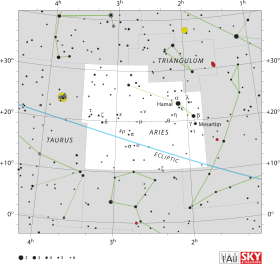|
4 Arietis est une étoile[9] de la constellation du Bélier. 4 Arietis est sa désignation de Flamsteed. Elle est visible à l'œil nu comme une étoile pâle, de couleur bleu-blanc, avec une magnitude apparente de 5,86[2]. L'étoile à un décallage annuel de la parallaxe de 11,46 ± 0,15 mas[1], ce qui équivaut à une distance de 285 al (87 pc) de la Terre. Elle s'éloigne du Système solaire avec une vitesse radiale héliocentrique de +6 km/s[5].
Il s'agit d'une étoile bleu-blanc de la séquence principale, avec un type spectral B9.5V[4]. Elle a 257 Ma[6] et tourne à une vitesse de rotation projetée de 33 km/s[6]. L'étoile a plus du double de la masse du Soleil et environ 2,2 fois le rayon du Soleil[7]. Elle rayonne 40 fois la luminosité du Soleil[3] depuis sa photosphère à une température effective de 10 913 K[6].
Notes et références
Notes
Références
- ↑ a b c d e et f
(en) A. G. A. Brown et al. (Gaia collaboration), « Gaia Data Release 2 : Summary of the contents and survey properties », Astronomy & Astrophysics, vol. 616, , article no A1 (DOI 10.1051/0004-6361/201833051, Bibcode 2018A&A...616A...1G, arXiv 1804.09365).
- ↑ a et b (en) T. Oja, « UBV photometry of FK4 and FK4 supplement stars », Astronomy & Astrophysics Supplement Series, vol. 52, , p. 131–134 (Bibcode 1983A&AS...52..131O)
- ↑ a b c et d (en) J. Zorec, F. Royer, Martin Asplund, Santi Cassisi, Ivan Ramirez, Jorge Melendez, Thomas Bensby et Sofia Feltzing, « Rotational velocities of A-type stars. IV. Evolution of rotational velocities », Astronomy & Astrophysics, vol. 537, , article no A120 (DOI 10.1051/0004-6361/201117691, Bibcode 2012A&A...537A.120Z, arXiv 1201.2052, S2CID 55586789)
- ↑ a et b (en) A. Cowley et al., « A study of the bright A stars. I. A catalogue of spectral classifications », The Astronomical Journal, vol. 74, , p. 375–406 (DOI 10.1086/110819, Bibcode 1969AJ.....74..375C)
- ↑ a et b (en) J. H. J. de Bruijne et A.-C. Eilers, « Radial velocities for the HIPPARCOS-Gaia Hundred-Thousand-Proper-Motion project », Astronomy & Astrophysics, vol. 546, , p. 14, article no A61 (DOI 10.1051/0004-6361/201219219, Bibcode 2012A&A...546A..61D, arXiv 1208.3048, S2CID 59451347)
- ↑ a b c d e f g et h (en) Trevor J. David et Lynne A. Hillenbrand, « The Ages of Early-Type Stars: Strömgren Photometric Methods Calibrated, Validated, Tested, and Applied to Hosts and Prospective Hosts of Directly Imaged Exoplanets », The Astronomical Journal, vol. 804, no 2, , p. 146 (DOI 10.1088/0004-637X/804/2/146, Bibcode 2015ApJ...804..146D, arXiv 1501.03154, S2CID 33401607)
- ↑ a et b (en) L. E. Pasinetti Fracassini et al., « Catalogue of Apparent Diameters and Absolute Radii of Stars (CADARS) », Astronomy & Astrophysics, vol. 367, no 2, , p. 521–524 (DOI 10.1051/0004-6361:20000451, Bibcode 2001A&A...367..521P, arXiv astro-ph/0012289, S2CID 425754)
- ↑ (en) 4 Ari sur la base de données Simbad du Centre de données astronomiques de Strasbourg.
- ↑ (en) P. P. Eggleton et A. A. Tokovinin, « A catalogue of multiplicity among bright stellar systems », Monthly Notices of the Royal Astronomical Society, vol. 389, no 2, , p. 869–879 (DOI 10.1111/j.1365-2966.2008.13596.x, Bibcode 2008MNRAS.389..869E, arXiv 0806.2878, S2CID 14878976)
Liens externes
- Ressource relative à l'astronomie
 : :
|
